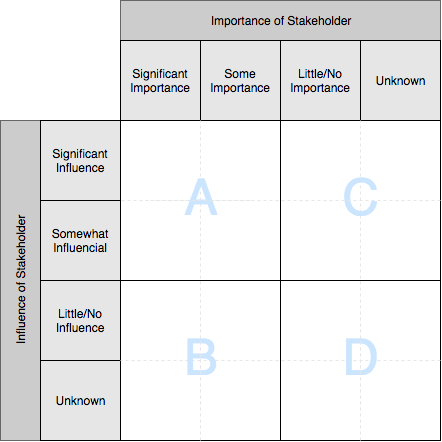Stakeholder Matrix

Table of Contents
A common method of stakeholder analysis is a Stakeholder Matrix. This is where stakeholders are plotted against two variables. These variables can be the importance of the stakeholder against their influence.
Matrix Diagram #

Boxes A, B and C are the key stakeholders of the project. Each box is summarised below:
Box A #
These are stakeholders who have a high degree of influence on the project and who are also of high importance for its success. Good working relationships with these stakeholders must be made.
Box B #
These are stakeholders of high importance to the success of the project, but with low influence. These are stakeholders who might be beneficiaries of a new service, but who have little ‘voice’ in its development.
Box C #
These are stakeholders with high influence, who can therefore affect the project outcomes, but whose interests are not necessarily aligned with the overall goals of the project.
Box D #
The stakeholders in this box, with low influence, or importance to the project objectives, may require limited monitoring or evaluation, but are of low priority.
How to Use #
- Make a list of all stakeholders.
- Write the name of each stakeholder on a post-it note or index card.
- Rank the stakeholders on a scale of one to five, according to one of the criteria on the matrix, such as ‘interest in the project outcomes’ or ‘interest in the subject’.
- Keeping this ranking for one of the criteria, plot the stakeholders against the other criteria of the matrix. This is where using post-it notes or removable cards are useful.
- Ask the following questions:
- Are there any surprises?
- Which stakeholders do we have the most/least contact with?
- Which stakeholders might we have to make special efforts to ensure engagement?